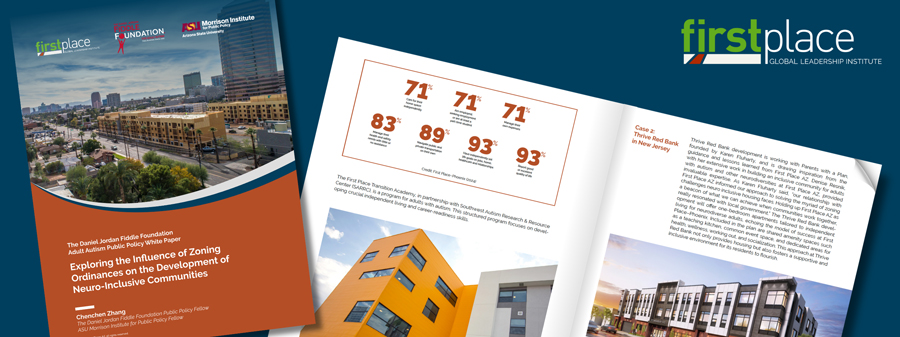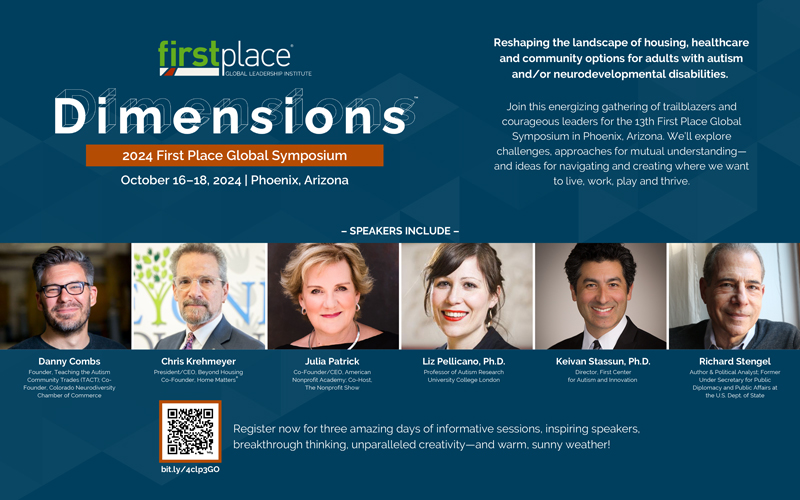Across the United States, there’s a growing focus on making communities more inclusive for individuals with autism and other developmental disabilities. This shift reflects a broader commitment to ensuring that all residents, regardless of their needs, can find supportive and accessible living environments. While zoning policies offer promising avenues for achieving this goal, significant hurdles remain.

Lyndsey Eaton and Lauren Heimerdinger, future residents, check out the First Place–Phoenix construction site in 2016. Photo credit: Good Eye! Media
Understanding the Barriers Created by Zoning
Zoning regulations play a critical role in shaping neighborhoods and communities, determining land use, building standards, and architectural styles. However, these regulations can also create barriers, particularly for low-income individuals and people with disabilities, including those with autism spectrum disorder (ASD).
Autism spectrum disorder encompasses a range of conditions that impact social skills, communication, and behavior. People with ASD may experience challenges in understanding social cues, making eye contact, or engaging in conversations, often accompanied by sensory sensitivities (NIH, 2020). These diverse challenges highlight the necessity for personalized support and comprehensive interventions that account for cultural, ethnic, and socioeconomic factors.
One way that zoning can support neuro-inclusive communities is through inclusionary zoning policies. These policies either require or encourage developers to set aside a portion of new or renovated housing units for low-income residents. In the U.S., over 1,000 jurisdictions have implemented some form of inclusionary zoning (Gentry et al., 2021). Policies can vary from mandatory to optional, with some cities offering incentives such as reduced parking requirements or expedited issuance of permits to facilitate compliance by developers. While cities in Arizona cannot mandate inclusionary zoning, they can offer voluntary measures that help incentivize developers (Gentry et al., 2021).
Zoning regulations also impact building design and accessibility. These rules often prescribe architectural standards and building features, contributing to the overall look and functionality of a neighborhood. Accessibility features, mandated by the Americans with Disabilities Act (ADA), ensure that new and renovated buildings accommodate individuals with disabilities (ADA Standards for Accessible Design, 2023). This includes everything from entrances and ramps to elevators and accessible restrooms.

The Daniel Jordan Fiddle Foundation Adult Autism Public Policy White Paper by Chenchen Zhang
However, zoning regulations can also create barriers. One major barrier is low-density zoning, a restrictive zoning practice that limits affordable housing options and exacerbates social and economic disparities (Massey & Rothwell, 2009). Such practices can unintentionally exclude individuals with disabilities and those with lower incomes from accessing adequate housing and community resources.
The costs associated with these modifications can also deter developers, limiting housing availability for people with disabilities. In cities like San Francisco, studies have shown that increased inclusionary zoning requirements can negatively impact property sales and construction activity, potentially worsening housing shortages (Bertolet & Durning, 2017).
Lengthy rezoning processes taking several months present another challenge, creating uncertainty for developers and discouraging investment in projects that could benefit neurodiverse communities. Zoning codes can also inadvertently restrict necessary modifications or housing arrangements for people with disabilities, necessitating a balance between regulatory compliance and inclusivity goals.
Legal challenges, such as Austin v. Town of Farmington, further illustrate the complexities of ensuring equitable treatment under existing zoning laws. This case highlights the tension between individual needs for reasonable accommodations and broader community concerns about zoning regulations, emphasizing the need for continuous legal and policy scrutiny.
Other obstacles include lengthy rezoning processes that create uncertainty for developers and discourage investment. Zoning codes can also inadvertently restrict necessary modifications or housing arrangements for people with disabilities. Addressing these issues requires a careful balance between regulatory compliance and the goal of fostering inclusive communities.
Promising Practices to Support Inclusive Communities
Despite these barriers, several promising practices demonstrate how thoughtful zoning can create more inclusive environments. Transit-oriented development (TOD) is one approach that focuses on building neighborhoods around high-quality public transit options, making it easier for residents to access essential services and amenities (Transit-Oriented Development, 2024). For example, First Place–Phoenix Apartments are designed to provide residents with proximity to transit, retail, and recreational facilities. By integrating residential spaces with public transit, TOD enhances accessibility and supports the needs of neurodiverse individuals.

Graphic from Chenchen Zhang’s White Paper
In Austin, Texas, incentive-based zoning strategies have successfully integrated therapeutic facilities into new developments (City of Austin, 2023). Developers who include therapy centers offering applied behavior analysis (ABA) therapy for individuals with autism can benefit from expedited permitting, density bonuses, and financial incentives. These measures promote mixed-use developments that address both housing and healthcare needs, making essential services more accessible to residents.
Mesa, Arizona, stands out as a leading example of an autism-friendly city. As the first autism-certified city in the U.S. as designated by the International Board of Credentialing and Continuing Education Standards (IBCCES), Mesa has implemented initiatives to make public spaces more accessible, including sensory guides for attractions and the Hidden Disabilities Sunflower Program, which assists individuals with invisible disabilities (Haas, 2023). Mesa’s approach demonstrates a strong commitment to inclusivity and ongoing community engagement.
Streamlining Zoning Approval Processes
To further support neuro-inclusive communities, cities should consider streamlining zoning approval processes. Simplifying applications, creating online portals, and reducing bureaucracy can improve efficiency and encourage developers to invest in inclusive projects. Collaborating with planning professionals and community stakeholders is crucial to ensure that updated ordinances reflect current needs and goals.
A Call to Action
Creating inclusive communities requires a concerted effort by cities, local governments, and stakeholders to implement promising practices in zoning and urban planning. Municipalities should regularly review and update zoning ordinances to avoid unintentionally creating or sustaining barriers that hinder the development of housing for adults with neurodevelopmental disabilities. On a statewide and federal level, governments can incentivize inclusive zoning through grants, policy guidance, and funding for accessibility initiatives. By embracing these changes, we can build a more equitable and supportive future for all residents, particularly those with developmental disabilities.
Chenchen Zhang delves into how zoning policies shape housing for individuals with ASD, aiming to identify ways to create more inclusive communities. Her work highlights the role of zoning regulations in supporting or hindering autism-friendly spaces and proposes policy changes for greater inclusivity. Through her research, Zhang seeks to improve living environments for individuals with autism, embodying a commitment to public service and advocacy for marginalized communities.
For more information about The Daniel Jordan Fiddle Foundation, visit djfiddlefoundation.org. For more information about the First Place Global Leadership Institute, visit firstplaceglobal.org. To contact Chenchen, email chenchen@firstplaceaz.org.
References
Bertolet, D., & Durning, A. (2016). Inclusionary zoning: The most promising—or counter-productive—of all housing policies. Sightline Institute. https://www.sightline.org/2016/11/29/inclusionary-zoning-the-most-promising-or-counter-productive-of-all-housing-policies/
The City of Austin. (2023). City of Austin affordable housing development incentive policy overview. www.austintexas.gov/sites/default/files/files/Housing_%26_Planning/Developer%20Incentive%20Matrix__01202023.pdf
Gentry, K., Irvine, B., & Cook-Davis, A. (2021). State-level legal barriers to adopting affordable housing policies in Arizona. Morrison Institute for Public Policy, Arizona State University. morrisoninstitute.asu.edu/sites/default/files/state-level-legal-barriers-to-adopting-affordable-housing-policies-in-arizona-nov-2021.pdf
Haas, M. (2023). In this Arizona city, kids with autism are more than welcome. Reasons to Be Cheerful. reasonstobecheerful.world/mesa-arizona-certified-autism-friendly-city-families/
Kenton, W. (2022). Zoning: What it is, how it works, classification examples. Investopedia. www.investopedia.com/terms/z/zoning.asp
Massey, D. S., & Rothwell, J. T. (2009). The effect of density zoning on racial segregation in U.S. urban areas. Urban Affairs Review 44(6): 779–806.







